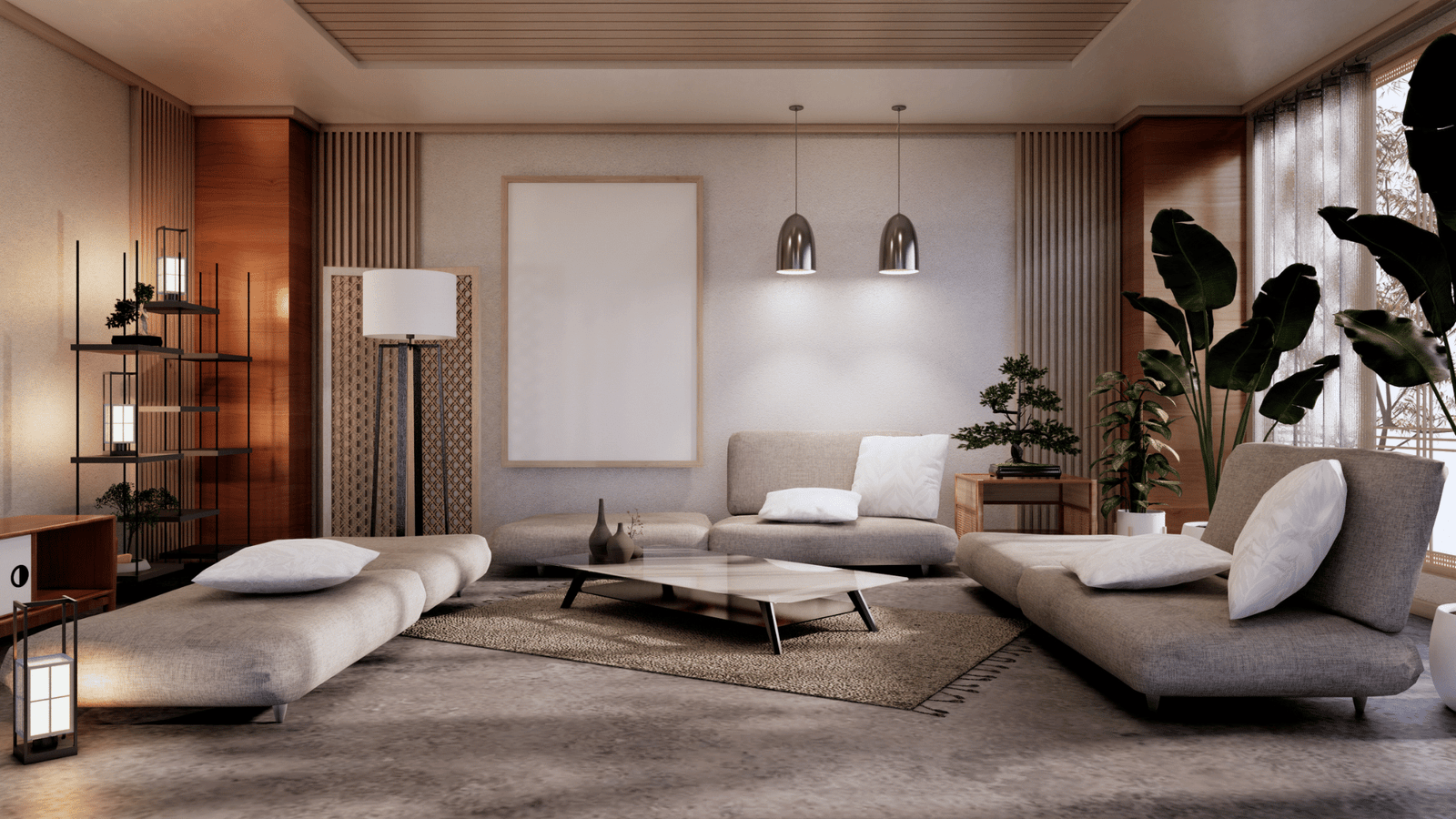Organic Modern Style combines clean lines with natural materials for a warm, modern feel. Use wood, stone, and linen to add texture and depth. Balance sleek surfaces with organic elements for a harmonious, inviting space.
Natural Materials: The Foundation of Organic Modern Style
In the ever-evolving world of interior design, natural materials have emerged as essential elements in organic modern spaces. These materials form the cornerstone of a design philosophy that bridges nature and contemporary living.
The journey of natural materials in design is fascinating, reflecting both our historical connection to nature and our modern understanding of sustainable living. From traditional applications to contemporary interpretations, these materials continue to shape how we create and experience spaces.
At its core, organic modern style celebrates raw, authentic materials like:
- Wood, stone, and bamboo
- Natural fibers like rattan and jute
What makes these materials particularly relevant today is their significant contribution to sustainability. In a world increasingly focused on environmental consciousness, natural materials offer both aesthetic appeal and ecological responsibility.
The beauty of natural materials lies in their versatility. When thoughtfully incorporated, they can:
- Create warm, inviting spaces
- Add rich, tactile textures
- Complement modern elements like glass and metal
By embracing natural materials, we’re not just designing spaces – we’re creating environments that connect us to nature while meeting contemporary needs for style and functionality.
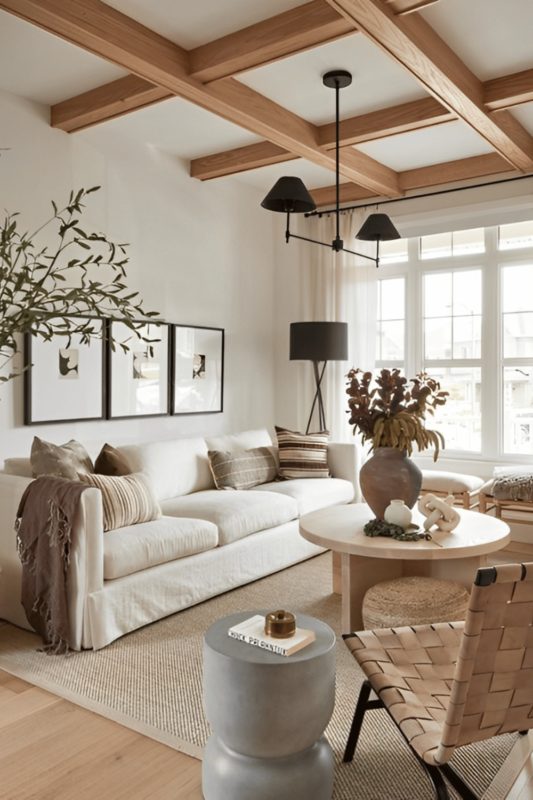
Building Blocks of Organic Modern Style
When it comes to creating authentic and sustainable spaces that stand the test of time, natural materials serve as the essential building blocks of modern design. These foundational elements not only bring beauty and functionality but also contribute to environmental consciousness. Let’s delve into an exploration of the three primary categories of natural materials that form the cornerstone of organic modern interiors, each bringing its own unique characteristics and applications to create harmonious living spaces.
1. Wood
The remarkable versatility of wood in design reveals itself through several fascinating aspects:
- Understanding the distinction between hardwoods and softwoods, each offering unique structural properties and aesthetic qualities
- Exploring various wood species and their unique characteristics, from the rich warmth of walnut to the light elegance of maple
- Different finishing techniques and treatment options that enhance both protection and visual appeal
2. Stone
Natural stone introduces timeless elegance and unparalleled durability to spaces, offering:
- Popular varieties include marble, granite, and slate, each bringing distinct patterns and textures
- Various ways to incorporate stone in design, from dramatic focal walls to subtle accents
- Understanding proper care and maintenance to preserve the stone’s natural beauty for generations
3. Natural Fibers
These versatile materials introduce essential texture and warmth to interiors, encompassing:
- Structural elements like bamboo and rattan, offering both strength and visual interest
- Decorative materials such as jute and sisal that add organic texture and natural charm
- Soft furnishing materials including cotton and wool, providing comfort and tactile appeal
These carefully chosen natural materials do more than simply please the eye – they create thoughtfully crafted environments that forge a meaningful connection between inhabitants and nature while fulfilling contemporary design requirements. Their thoughtful incorporation into organic modern style speaks to both our deep-rooted connection with the natural world and our growing commitment to sustainable living practices, creating spaces that are both environmentally conscious and aesthetically sophisticated.
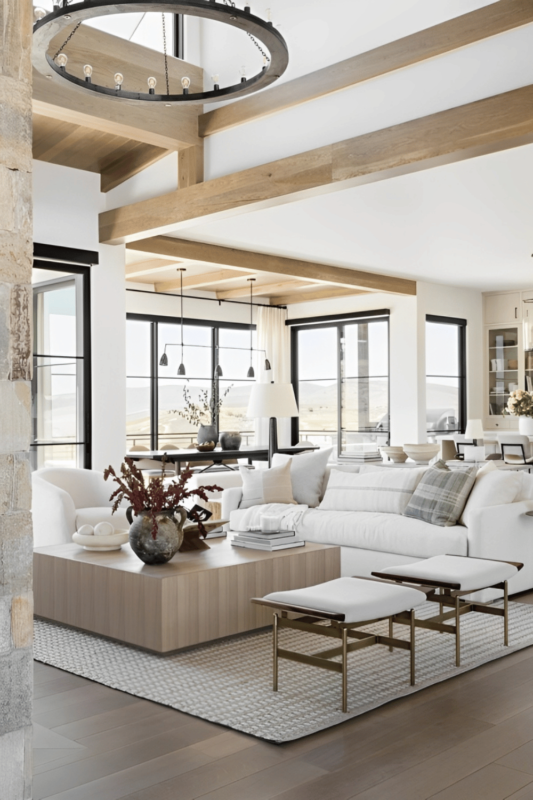
Integration in Modern Design: Bridging Nature and Contemporary Living
The seamless integration of natural materials into modern design creates spaces that are both sophisticated and grounded, offering a harmonious blend of organic elements within contemporary settings. By carefully considering the placement and interaction of natural materials, designers can create environments that speak to both our innate connection with nature and our modern aesthetic sensibilities. Let’s explore the thoughtful ways these elements are being incorporated into contemporary interiors:
Furniture Applications
Natural materials are making bold and innovative statements in furniture design. From elegantly simple forms to intricately sculptural pieces, furniture showcases the raw beauty of wood, stone, and other organic materials while maintaining clean, contemporary lines. The careful selection of these materials allows each piece to serve as both a functional element and an artistic expression of natural beauty.
Architectural Elements
The architectural integration of natural materials establishes a strong foundation for organic modern spaces. Large windows and thoughtfully designed open floor plans serve as key features that seamlessly merge indoor and outdoor environments. The sophisticated combination of natural and modern materials – including glass, metal, and concrete – creates a carefully balanced aesthetic that celebrates both traditional and contemporary elements. This architectural approach allows natural light to play across surfaces, highlighting the inherent beauty of each material.
Decorative Features
The decorative layer introduces warmth and personality through carefully curated handcrafted items, natural fiber textiles, and artisanal pottery. These thoughtfully selected elements add character and depth while maintaining the clean, minimalist approach that defines organic modern design. Each decorative piece tells its own story while contributing to the overall harmony of the space.
Textural Combinations
The intentional interplay of different textures serves as an essential element in organic modern design. Raw, organic surfaces create rich tactile interest, while the carefully considered mixture of materials adds sophisticated depth and visual intrigue to spaces. This layered approach to texture creates environments that engage multiple senses while maintaining visual coherence.
This comprehensive integration approach creates environments that deeply honor our connection to nature while fully embracing contemporary design principles. The result is the creation of spaces that are not only timeless and forward-thinking but also deeply resonant with our natural instincts and modern sensibilities. Through this thoughtful combination of elements, organic modern design achieves a perfect balance between innovation and tradition, sophistication and comfort.
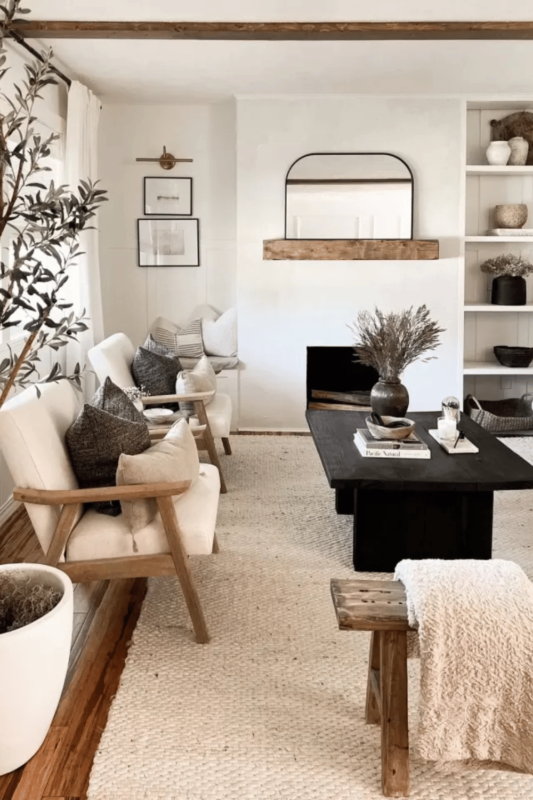
The Benefits of Natural Materials in Modern Design
Natural materials have emerged as indispensable elements in contemporary interior design, offering a remarkable array of benefits that transcend purely aesthetic considerations. As we delve into the multifaceted advantages of incorporating these materials into your living spaces, we’ll discover how they transform both the physical environment and our daily experiences within it.
Environmental Impact
Natural materials serve as cornerstones of sustainable design, embodying our deepening commitment to environmental stewardship. By selecting organic materials, you’re not only supporting eco-friendly practices and reducing your carbon footprint, but also contributing to the preservation of traditional craftsmanship and local resource management. These choices ripple through the supply chain, encouraging sustainable harvesting practices and responsible manufacturing processes.
Health and Wellness Benefits
The thoughtful integration of natural materials creates environments that forge authentic connections with nature, promoting both physical and psychological well-being. These materials often possess inherent properties that can improve indoor air quality, regulate humidity levels, and create more balanced acoustic environments. The presence of natural elements has been shown to reduce stress levels, enhance cognitive function, and contribute to more restful living spaces.
Aesthetic Advantages
Natural materials introduce an unparalleled level of beauty and versatility to interior spaces. They can:
- Create warm and inviting environments that evolve with character over time
- Add rich, tactile textures that engage the senses and enhance visual depth
- Seamlessly blend with modern elements like glass and metal while maintaining their organic appeal
- Provide unique patterns and variations that make each space truly one-of-a-kind
Durability and Longevity
Premium natural materials such as hardwood and stone demonstrate exceptional durability while developing a distinctive patina that enhances their beauty over time. When properly maintained, these materials can persist for generations, often becoming more valuable and characterful with age. This remarkable longevity, combined with their timeless appeal, makes natural materials an exceptionally wise investment for both residential and commercial spaces.
From foundational structural elements to sophisticated decorative features, natural materials expertly craft environments that are simultaneously refined and grounded, achieving a perfect balance between timeless elegance and contemporary innovation. Their versatility allows for endless creative possibilities while maintaining a strong connection to the natural world.
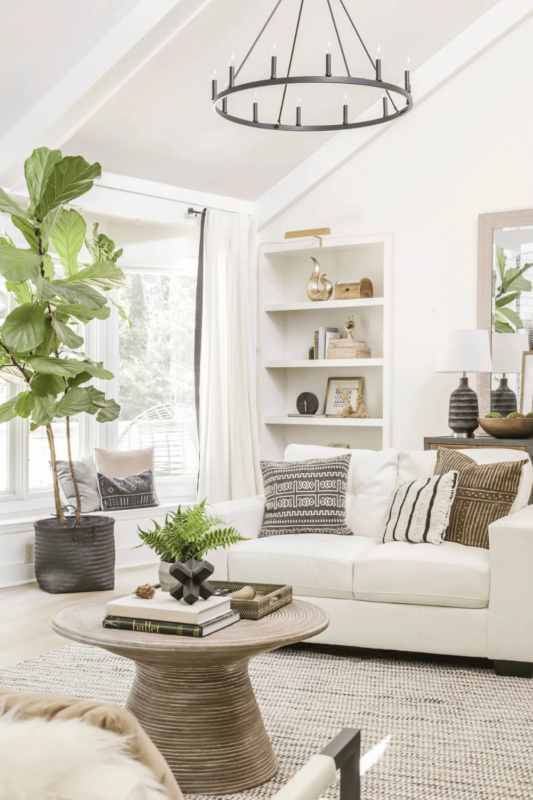
A Guide to Selection and Maintenance of Natural Materials in Modern Design
When incorporating natural materials into your organic modern space, thoughtful selection and diligent maintenance practices are essential foundations for achieving lasting beauty and functionality. The following comprehensive guide will help you navigate the important considerations and best practices for ensuring your natural materials stand the test of time:
Selecting Quality Materials
When evaluating natural materials for your space, carefully consider these critical factors:
- Authenticity and sourcing – thoroughly investigate and verify the material’s origin, chain of custody, and comprehensive sustainability credentials to ensure ethical and environmentally responsible sourcing
- Grade and quality – conduct detailed examinations of material consistency, structural durability, and distinctive natural characteristics that will enhance your space’s unique aesthetic appeal
- Intended use – carefully evaluate whether the material’s properties align with its intended purpose, location, and expected wear patterns in your space
Maintenance Best Practices
To ensure your natural materials retain their inherent beauty and structural integrity over time:
- Develop a comprehensive and systematic cleaning routine tailored specifically to each material’s unique properties and maintenance requirements
- Research and implement appropriate cleaning products and techniques that will protect and preserve the material’s natural characteristics
- Establish protocols for immediate response to spills and damage to prevent potential long-term deterioration or permanent marking
Cost Considerations
When developing your budget for natural materials, take into account these important financial aspects:
- Create a detailed analysis of both initial purchase costs and projected long-term maintenance expenses over the material’s lifetime
- Evaluate the material’s durability and expected lifespan to determine its true value proposition and return on investment
- Include comprehensive calculations for professional installation costs and potential future maintenance or repair requirements
Sourcing Guidelines
To ensure responsible and reliable material procurement:
- Conduct thorough research into potential suppliers, examining their reputation, sustainability practices, and commitment to environmental stewardship
- Always obtain and carefully evaluate material samples before committing to larger purchases to ensure consistency and quality
- Meticulously verify all relevant certifications and environmental standards to ensure compliance with sustainability goals
By following these comprehensive guidelines and best practices, you can ensure your carefully selected natural materials not only maintain their intrinsic beauty but also contribute meaningfully to creating a sustainable and timeless design that will be enjoyed for generations to come.
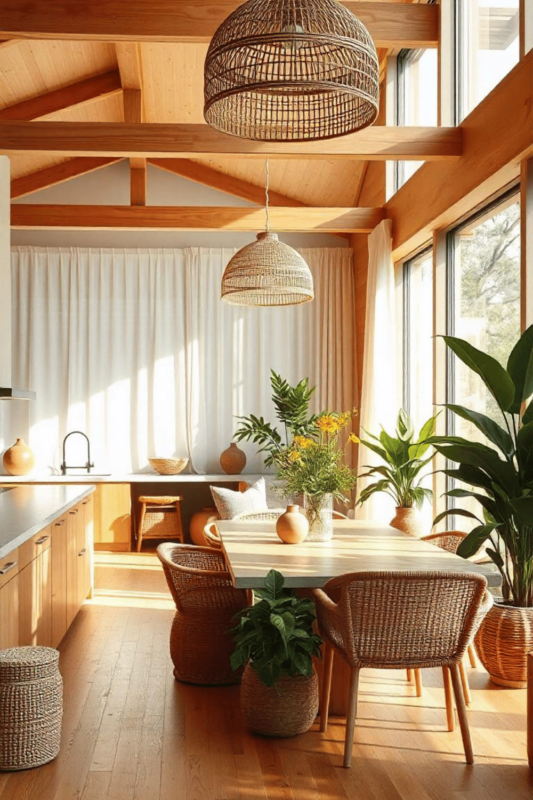
Mastering Design Tips and Best Practices in Organic Modern Interiors
Creating a harmonious organic modern space requires thoughtful consideration and masterful execution of several interconnected design principles. Let’s explore each essential element in detail to help you achieve the perfect balance in your space:
Material Combinations
The sophisticated art of combining materials stands as a cornerstone of organic modern style. The key lies in thoughtfully blending natural elements like richly textured wood and carefully selected stone with contemporary materials such as sleek glass and polished metal. This intentional fusion creates a carefully balanced aesthetic that pays homage to both the raw beauty of nature and the refined sensibilities of modern design. Consider how each material’s unique characteristics can complement and enhance the others, creating layers of visual and tactile interest.
Color Coordination
Developing your color palette requires a nuanced approach centered around earth tones, warm neutrals, crisp whites, and gentle beiges. These carefully selected hues work together to create a serene and sophisticated backdrop that allows the natural beauty of your materials to take center stage while maintaining the clean, modern aesthetic. Consider how different lighting conditions throughout the day will interact with your chosen colors to create varying moods and atmospheres.
Balance and Proportion
The art of balance in organic modern style lies in masterfully combining clean, architectural lines with soft, organic curves and fluid forms. This delicate interplay requires maintaining a minimalist approach while ensuring the space feels welcoming and naturally harmonious. Pay special attention to the scale and proportion of each element, ensuring they work together to create a cohesive whole that feels both sophisticated and inviting.
Space Planning
Thoughtful space planning forms the foundation of successful organic modern style. Prioritize creating open, flowing floor plans that establish seamless transitions between indoor and outdoor spaces. The strategic incorporation of expansive windows and abundant natural light plays a crucial role in strengthening the connection with nature. Consider how people will move through the space and how different areas will interact with one another throughout the day.
Remember that the true essence of successful organic modern style lies in creating environments that masterfully balance sophistication with groundedness. The key is crafting spaces where natural elements and contemporary design principles work in perfect harmony, resulting in interiors that feel both timeless and thoroughly modern. Each decision, from material selection to space planning, should contribute to this delicate balance, creating environments that are both visually stunning and deeply comfortable.
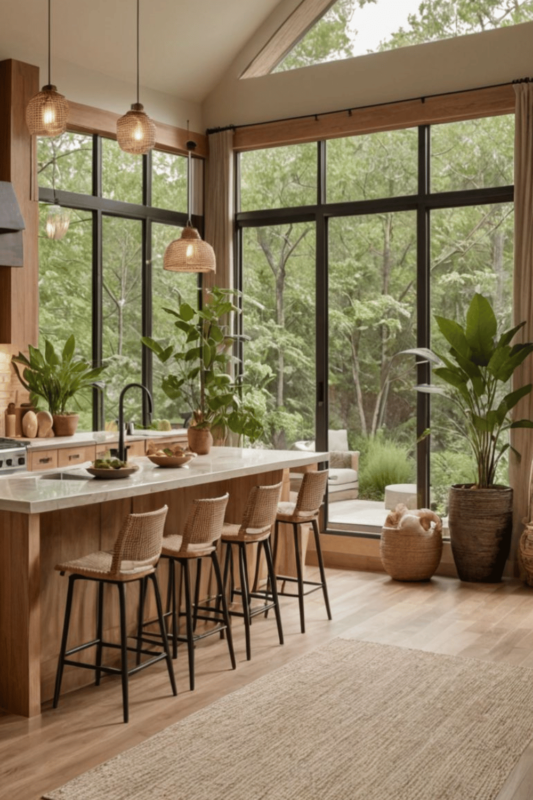
Residential Transformation: The Cedar Lake House
This lakeside residence showcases the transformative power of natural materials in modern architecture. The home’s design expertly integrates elements that honor both contemporary aesthetics and the surrounding landscape. The architects incorporated locally sourced materials—including restored reclaimed wood beams that add character and history, regional stone that anchors the structure to its environment, and floor-to-ceiling windows that create an immersive outdoor connection. These elements create a seamless flow between interior and exterior spaces, dissolving traditional boundaries between home and nature. The result is remarkable: a sophisticated living space that perfectly balances modern luxury with an authentic connection to its natural surroundings.
Commercial Success: The Evergreen Office Complex
A forward-thinking tech company transformed their workplace by embracing organic modern design principles. They implemented sustainable materials and biophilic elements throughout the space, including bamboo partitions that created defined yet open areas, living walls that brought nature indoors, and natural stone flooring that provided both sophistication and durability. These thoughtful design choices yielded measurable results: employee satisfaction increased by 40%, while energy efficiency initiatives reduced operational costs by 25%.
Key Lessons from Real Projects
- Natural materials demand comprehensive planning and regular maintenance strategies to ensure their longevity and preserve their inherent beauty over time
- The strategic decision to invest in premium-quality materials consistently proves worthwhile through their superior durability, timeless aesthetic appeal, and reduced long-term maintenance requirements
- Successful implementation of organic modern design requires careful consideration of practical factors such as humidity levels, daily wear patterns, and specific maintenance needs while maintaining aesthetic excellence
- The thoughtful integration of natural elements with modern materials and design principles consistently produces the most compelling and emotionally resonant spaces
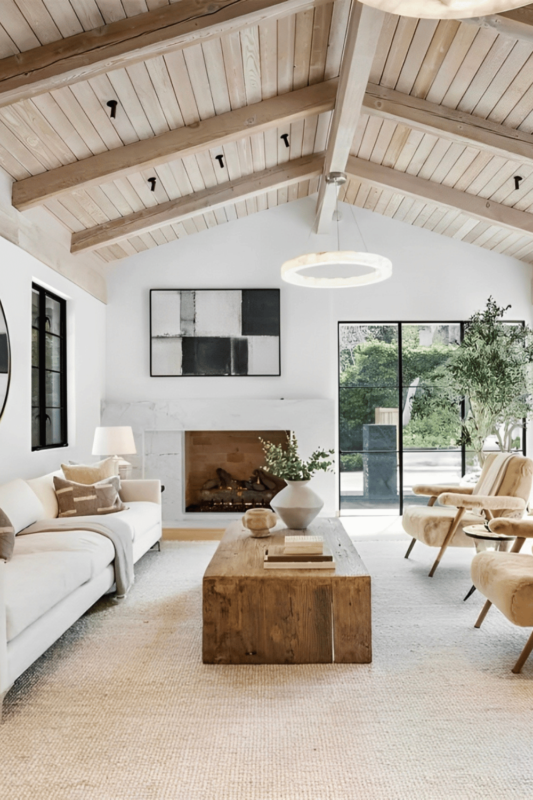
Future Trends in Natural Materials
The future of organic modern style is transforming rapidly, with innovations emerging at an unprecedented pace. We stand at the intersection of tradition and innovation, where natural materials are being reimagined in extraordinary ways. Let’s explore the key trends reshaping natural materials in contemporary design.
Emerging Materials
Bio-based materials are revolutionizing design, offering new possibilities for sustainable construction and decoration. Mycelium composites from fungal networks serve as versatile building blocks, while algae-based materials show promise for both structural and decorative uses. Advanced bamboo technologies are expanding this traditional material’s potential. These alternatives to conventional building materials are opening new avenues for creative expression while maintaining environmental responsibility.
Innovative Applications
Technology is transforming how we use natural materials. Smart wood responds dynamically to environmental conditions, while self-healing surfaces offer enhanced durability. Biomimetic designs replicate nature’s most efficient solutions, and advanced 3D-printing techniques enable intricate forms while preserving natural materials’ authentic character.
Sustainable Developments
Sustainability now drives innovation in natural materials. Carbon-negative materials actively benefit the environment, while closed-loop manufacturing eliminates waste. Advanced recycling technologies expand material recovery and reuse, enabling circular design. These developments make it easier to create spaces that are both beautiful and environmentally regenerative, ensuring sustainable design for generations to come.
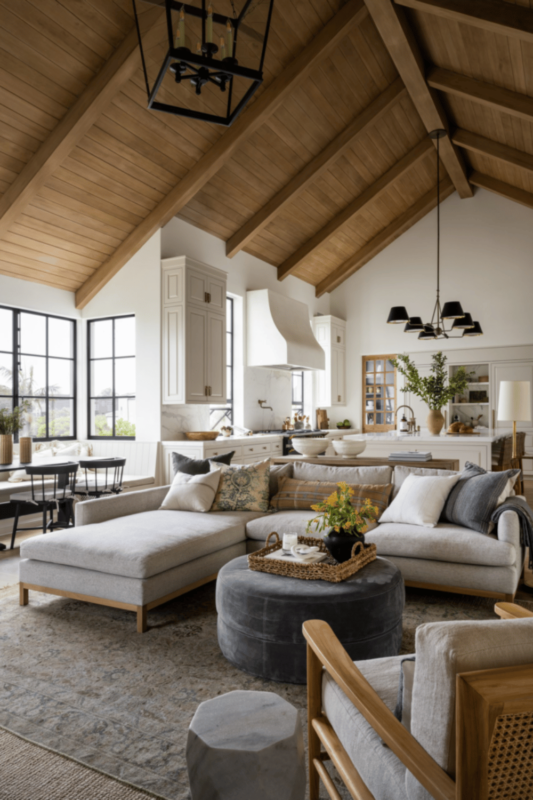
Conclusion
Natural materials are more than design elements—they are foundational building blocks that create sustainable, healthy, and emotionally resonant environments. By integrating carefully selected wood, thoughtfully sourced stone, and artisanal natural fibers into contemporary design, we create spaces that honor nature’s timeless beauty while embracing modern sophistication. These materials bring an authenticity and vitality to our surroundings that synthetic alternatives cannot replicate.
The organic modern style movement continues to evolve through innovations in sustainable materials and eco-conscious manufacturing. From smart wood that adapts to environmental conditions to revolutionary bio-based composites, new opportunities are emerging to incorporate natural elements into our built environments. These advances enhance both functionality and our connection to nature.
Whether renovating or building new, remember that successful organic modern style balances natural elements with contemporary features. Through careful material selection, proper maintenance, and proven design principles, you can create spaces that endure and embrace sustainable design’s future.
Ready to transform your space? Start by identifying one area where organic elements could make an impact, letting organic modern style principles guide your way. Remember that meaningful change begins with a single step toward creating a more sustainable and beautiful living environment. Your journey to a more harmonious, naturally inspired space begins with your first choice.
>> Learn more: Modern Coastal Dining Room Ideas to Create a Seaside Oasis


